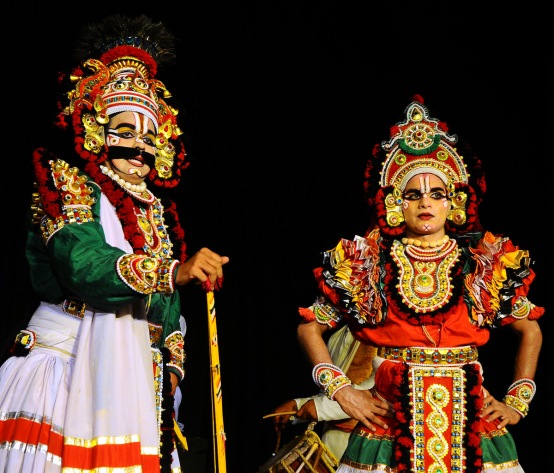Hello Peeps!!
My letter for the Day is ‘Y’
Yakshagana is a traditional dance drama form that contains dance, music, makeup, dialogue and costume. It is popular in different parts of Karnataka. The stories of this dance form are drawn from epics like Ramayana, Mahabharata etc.
Yakshagana is strongly influenced by the Vaishnava Bhakti movement. Yakshagana was first introduced in Udupi by Madhvacharya’s disciple Naraharitirtha.
How to perform this dance?

A traditional Yakshagana performance begins with the initial beating of drums called ‘Abbara or Peetike’. It may last for an hour and then the actors finally arrive on stage.
The entire performance consists of background music by a group of musicians (Himmela), a dance and a dialog group (Mummela). The Himmela, has their lead singer, known as ‘Bhagavatar’ who directs the production and known as the ‘First Actor’.
Instruments:

Additional members of the Himmela, play the traditional musical instruments such as maddale (hand drum), the pungi (pipe), hermonium (organ) and chande (loud drum).
The music is based on ragas, which are characterized by rhythmic patterns called mattu and tala.
Costumes:
In this dance form, makeup and costume both play the important roles. The Yakshaghana performers have expertise on makeup. The lead performer (Bannada Vesha) spends four to five hours to get into the character.
The performers wear full sleeved upper garments green or red in color and in lower part they wear the dhoti with a typical draping style known as ‘Veeragacche’.

If the character is of ‘Yama’ – the god of death then dancers wear a lion’s head or that of a demon and the girth of the character will be increased three fold with the help of thick sheets of cloth or sarees tied round the body. The color of the garments indicates the character. Like for Demons the costume will be black or dark color and for King, dress color will be reddish brown.
The ornaments used are: bead necklaces and garlands, patti, koralahara, and sage around the neck, Bhujakeerti for the elbow, Tola pavada for the wrist, gold plates for the arms, crown for the head with Karnapatra (wings attached to the crown), Kennappo for the ear, Dagale the flowing piece of embroidered cloth falling in front from the waist, and jingles around the ankles. There are significant head-dresses and crowns with pronounced differences in shape and size.

The most prominent crowns are Battalu Kireeta with a great halo, worn by royal characters like Dasaratha and Dharmaraja, Pombe Kireeta worn by characters like Lord Rama and Arjuna, Rakkasi Kireeta with peacock feathers worn by demons like Shurpanakhi and Hanumanthana Kireeta for Hanuman. A circular halo of the headdress made of white and black cloth decorated with silver lace tape and peacock feathers is called Sirimudi and is worn by characters like Lord Krishna and Abhimanyu. Sirimudi is in the shape of the human heart and is made in varying sizes and colours specifically for different characters. The size of the Sirimudi is symbolic of the stature of the character which wears it.

After makeup and costume, the characters complete the look by holding the relevant weapon – the mace, sword or the bow and arrow.
Sharing here videos of Yakshagana:
See what dance form I have shared for the letter ‘X’
What will be my next dance form for the letter ‘Z’?

This post is in association with #BlogchatterA2Z
Are you enjoying this #DanceKaPunchnama? Please comment below.
Source: Wikipedia, Britannica, Indianetzone
![]()









One thought on “Yakshagana A to Z Challenge April 2018 #DanceKaPunchnama”